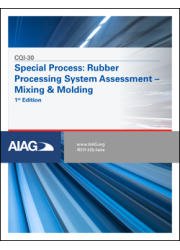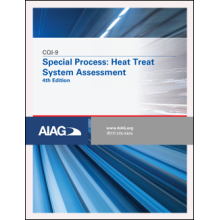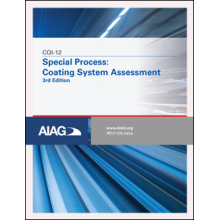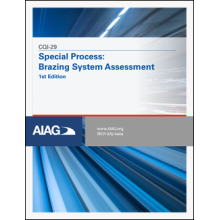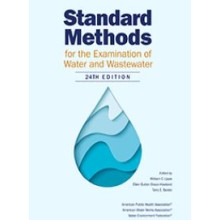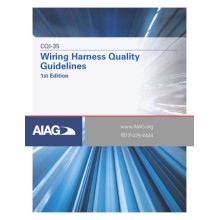CQI-30 Special Process: Rubber Processing System Assessment - Mixing & Molding 1st Edition 2022
Our Price: $213.00
Discount : 25%
Quantity:
-
Add to Compare
Developed in collaboration with industry experts from OEMs, Tier 1 suppliers, and molding suppliers, the CQI-30 Special Process: Rubber Processing System Assessment provides a common approach to a rubber mixing and molding management system for automotive production and service part organizations.
Rubber is used to seal mating parts within the engine such as:
- Engine Mounts
- Body Mounts
- Torsional Vibration Dampers
- Valve Stems seals
- Pan gaskets (oil pan, transmission pan)
- The front cover of the engine
- Water pump seals
- Oil pump seals
- Spark plug tube seals
- Fuel injector seals
- Fuel rail seals
- Coolant pass through
- Intake manifold gaskets
- Rotating shaft seals (Engine cranks, power distribution seals, etc.)
- Shock absorber seals
- Axel & wheel seals
- U-joint bearing seals
- CVJ Boots
- Steering rack boots
- Pinion seals
- Battery containment seals for EVs
- Battery connection seals for EVs
- Transmission piston seals
- Oil filler cap seals
- Fuel tank sender seals
- …and numerous internal seals in the forms of o-rings and special molded shapes
These are all in the area of engine propulsion.
Using constant improvement tools, the intent of the CQI-30 assessment is to provide for the greatest consistency in rubber part production, and thereby the most consistent and predictable performance of the rubber article, which starts with controlling as many of the inputs into that process as possible. This is why we started with the rubber mixing process, followed by the metal treating process, and then the molding processes. The target is to identify variations in the process that may cause unpredictable or interrupted product function. When that happens, expense is incurred by the consumer (and potentially the manufacturer), leading to customer dissatisfaction and potential loss of that customer.
Using the list above, it’s easy to recognize that if one had to replace any of those articles, it would cost hundreds of dollars – and in some cases, like an intake manifold gasket, thousands of dollars. Likewise, many of those items listed are critical safety items, such as fuel injector seals. Failure of these items can result in potential harm for the driver and possible recall of the model.
This assessment will add a level of confidence for users that their processes are the most consistent they can be, and therefore, their quality remains as high as possible for the products being manufactured.
Developed in collaboration with industry experts from OEMs, Tier 1 suppliers, and molding suppliers, the CQI-30 Special Process: Rubber Processing System Assessment - Mixing & Molding 1st Edition 2022 provides a common approach to a rubber mixing and molding management system for automotive production and service part organizations.
Rubber is used to seal mating parts within the engine such as:
- Engine Mounts
- Body Mounts
- Torsional Vibration Dampers
- Valve Stems seals
- Pan gaskets (oil pan, transmission pan)
- The front cover of the engine
- Water pump seals
- Oil pump seals
- Spark plug tube seals
- Fuel injector seals
- Fuel rail seals
- Coolant pass through
- Intake manifold gaskets
- Rotating shaft seals (Engine cranks, power distribution seals, etc.)
- Shock absorber seals
- Axel & wheel seals
- U-joint bearing seals
- CVJ Boots
- Steering rack boots
- Pinion seals
- Battery containment seals for EVs
- Battery connection seals for EVs
- Transmission piston seals
- Oil filler cap seals
- Fuel tank sender seals
- …and numerous internal seals in the forms of o-rings and special molded shapes
These are all in the area of engine propulsion.
Using constant improvement tools, the intent of the CQI-30 assessment is to provide for the greatest consistency in rubber part production, and thereby the most consistent and predictable performance of the rubber article, which starts with controlling as many of the inputs into that process as possible. This is why we started with the rubber mixing process, followed by the metal treating process, and then the molding processes. The target is to identify variations in the process that may cause unpredictable or interrupted product function. When that happens, expense is incurred by the consumer (and potentially the manufacturer), leading to customer dissatisfaction and potential loss of that customer.
Using the list above, it’s easy to recognize that if one had to replace any of those articles, it would cost hundreds of dollars – and in some cases, like an intake manifold gasket, thousands of dollars. Likewise, many of those items listed are critical safety items, such as fuel injector seals. Failure of these items can result in potential harm for the driver and possible recall of the model.
This assessment will add a level of confidence for users that their processes are the most consistent they can be, and therefore, their quality remains as high as possible for the products being manufactured.
Write a review
Your Name:Your Review: Note: HTML is not translated!
Rating: Bad Good
Enter the code in the box below:
Copyright © 2014 Engineering Standards Bureau. All Rights Reserved.
Developed By Zoom Into Web


